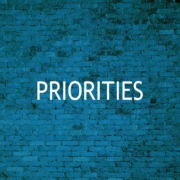When leaders and their teams are not on the same page
Joe, a talented CEO, came to me with a complaint. “My staff spends too much time on projects that are not high-priority,” he said. The projects were important, he admitted, but not at the top of the list.
Joe was frustrated because he had worked so hard on a strategic plan that was supposed to guide everyone’s work. Now it wasn’t being followed!
When I asked Joe to tell me how he prioritizes projects for his staff, he stopped talking. I could tell that he was having an “awakening moment.” Joe realized that he had not communicated his priorities often enough, or clearly enough, to his team.
Getting your entire staff on the same page requires more than one announcement about your key priorities.
This is where the disconnect happens. Leaders insist that they’ve communicated with their teams. But if the teams are not aligning their work with the organization’s key priorities, the message was not received – because it was unclear, vague, too short, or the team didn’t feel it applied to them.
Getting your entire staff on the same page, aligned with your key priorities, takes more than one announcement. It must be reinforced constantly, with check-ins, reminders, and measurement.
It’s hard work, but it’s worth it. When leaders and teams are on the same page, you’ll see results.
Sherri Miller, Founder and CEO
Center For Extraordinary Success









